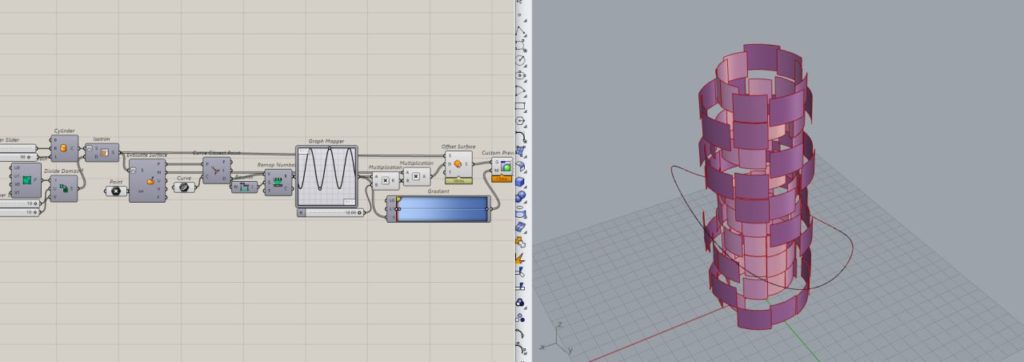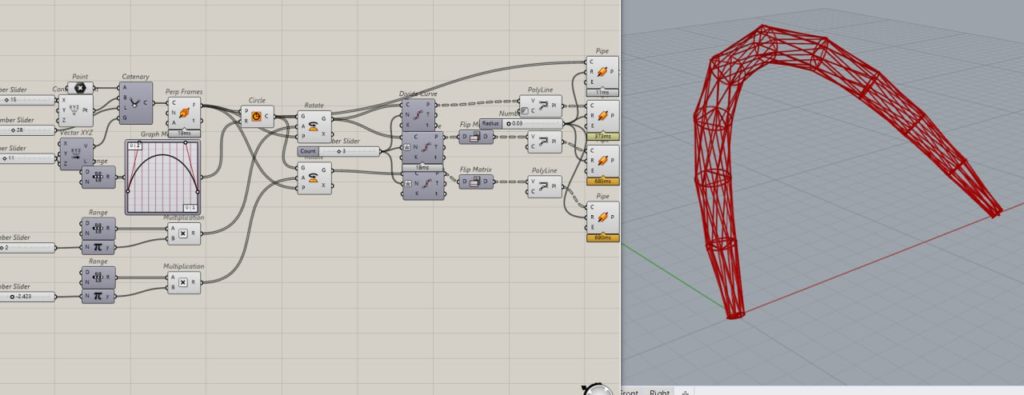Embark on a transformative journey into the realm of digital design with our “Advanced Digital Tools” course, where innovation meets precision. Central to this exploration is Grasshopper, a visual programming language seamlessly integrated into Rhino 3D modeling software.
This course propels students beyond conventional design boundaries, offering a hands-on experience in parametric design, algorithmic workflows, and computational design. As we navigate the intricate landscape of Grasshopper, participants gain the skills to bring their digital visions to life.
By mastering these advanced digital tools, students not only acquire technical proficiency but also cultivate a mindset of innovation. Join us in reshaping the future of design as we bridge the gap between technology and art.
My Grasshopper Journey: Sharing Hands-On Experiences and Exercises
Now, let’s dive into my experiences and exercises with Grasshopper, where each project became a canvas for creativity and technical mastery.
Ex 01 : Attractor Points
In my exploration of Grasshopper, one of my initial exercises centered around the fascinating concept of attractor points. These exercises delved into the dynamic relationship between points and curves, unleashing a world of creative possibilities.


Attractor Points and Curves Algorithm:
- Define Points:
- Start by generating a set of points in your design space, representing the foundation of your composition.
- Attractor Point Selection:
- Choose a specific point, the “attractor,” which will influence the behavior of nearby elements.
- Calculate Distances:
- Measure the distance between each point and the attractor point.
- Attracting Force:
- Establish a mathematical relationship that defines how strongly each point is attracted to the chosen attractor point.
- Adjusting Curves:
- Utilize the calculated distances and forces to modify the shape and trajectory of curves in your design.
- Iterate and Refine:
- Fine-tune parameters iteratively, observing the evolving interaction between attractor points and curves.
This algorithm offers a glimpse into the captivating synergy between mathematical precision and artistic expression within Grasshopper, setting the stage for further explorations in computational design.
Ex 02: Data Management
In another captivating Grasshopper exercise, I embarked on the challenge of recreating the iconic arches of Wembley Stadium. Leveraging the power of circles, divisions, and rotations, I navigated the realm of data management and structure creation.

Wembley Stadium Arch Algorithm:
- Create Circles:
- Generate a series of circles, each representing a foundational element of the arch.
- Divide Circles:
- Divide each circle into segments, establishing the basis for the arch’s intricate structure.
- Rotate Elements:
- Introduce rotational transformations to the divided elements, orchestrating the arch’s curvature.
- Connect Points:
- Establish connections between points on the rotated circles, shaping the arch’s form.
- Data Management with Flip Matrix:
- Instead of conventional shift list techniques, employ the flip matrix operation for efficient data management.
- Iterate and Optimize:
- Refine the parameters and operations iteratively, observing the evolving precision and elegance of the Wembley arch.
This exercise not only replicated the architectural marvel of Wembley Stadium but also showcased the flexibility and ingenuity made possible through Grasshopper’s data manipulation tools.
Ex 03 : Parametric Tower
In the culmination of my Grasshopper journey, I embarked on an exhilarating assignment—breathing life into a parametric tower through dynamic animation. This endeavor involved weaving intricate algorithms, leveraging the power of data management, and seamlessly integrating various elements to craft a mesmerizing parametric design.
Parametric Tower Animation Algorithm:
- Define Tower Parameters:
- Establish key parameters such as height, width, and form that will govern the tower’s parametric design.
- Mesh as Tiles:
- Utilize mesh structures as the building blocks, paving the way for a dynamic and adaptable design.
- Data Trees and Management:
- Implement advanced data tree structures for efficient organization and manipulation of data, ensuring a seamless integration of diverse elements.
- Algorithmic Fusion:
- Integrate multiple algorithms, each contributing to a specific facet of the tower’s animation—fusing creativity with precision.
- Animate the Tower:
- Employ Grasshopper’s animation capabilities to bring the parametric tower to life, showcasing the dynamic evolution of its form.
- Iterative Refinement:
- Fine-tune the algorithms iteratively, observing the ever-changing interplay of mesh tiles and parametric design elements.
This assignment not only encapsulated the essence of parametric design but also underscored the limitless possibilities when combining data management, mesh structures, and animation within the Grasshopper environment.

